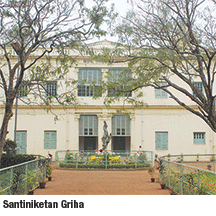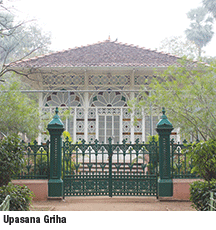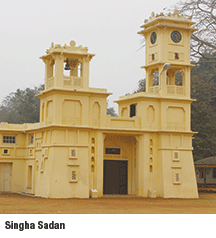VBU’s historic buildings
 Santiniketan Griha. Originally constructed by Rabindranath Tagore’s father Dwarkanath in 1863 for meditation, it became the poet’s base when he first came to Santiniketan in 1901 with the intention of setting up a school. Most of his famous poems from Gitanjali for which he won the Nobel Prize in 1913, were composed in this house. Today this structure is a guest house for luminaries such as the prime minister of India (ex officio chancellor of VBU) and other dignitaries. A museum on the first floor hosts several famous portraits of the poet, his father and Mahatma Gandhi, drawn by renowned artists such as William Blackstone and Jamini Roy.
Santiniketan Griha. Originally constructed by Rabindranath Tagore’s father Dwarkanath in 1863 for meditation, it became the poet’s base when he first came to Santiniketan in 1901 with the intention of setting up a school. Most of his famous poems from Gitanjali for which he won the Nobel Prize in 1913, were composed in this house. Today this structure is a guest house for luminaries such as the prime minister of India (ex officio chancellor of VBU) and other dignitaries. A museum on the first floor hosts several famous portraits of the poet, his father and Mahatma Gandhi, drawn by renowned artists such as William Blackstone and Jamini Roy.
Mrinalini Ananda Pathshala. Technically the pre-primary section of the school, it hosts preschool children upto age five. The Visva-Bharati University campus houses two primary schools — the Patha Bhavan in Santiniketan and the Siksha Satra in Sriniketan. The higher secondary sections of both schools have been merged for convenience.
 Prayer hall (Upasana Griha). Made entirely of Belgian glass, this is undoubtedly the most aesthetically appealing structure on the campus. Brahmo Samaj tradition prayer meetings are held in the Upasana Griha every Wednesday and were led by Tagore during his lifetime. Several annual functions such as the nabo borsho (Bengali new year) are staged in the prayer hall, a monument to cultural unity.
Prayer hall (Upasana Griha). Made entirely of Belgian glass, this is undoubtedly the most aesthetically appealing structure on the campus. Brahmo Samaj tradition prayer meetings are held in the Upasana Griha every Wednesday and were led by Tagore during his lifetime. Several annual functions such as the nabo borsho (Bengali new year) are staged in the prayer hall, a monument to cultural unity.
Patha Bhavan Office. Widely regarded as the architectural marvel of Santiniketan, this structure is reminiscent of ancient Buddhist shrines. The frescos of this building were created by renowned Bengali artist Nandalal Bose who was awarded the title of shilpacharya.
Uttarayan Houses. The five structures of the Uttarayan complex were designed by the poet’s son Rathindranath, Shilpacharya Nandalal Bose and renowned artist Suren Kar. These houses are of historical significance because they hosted Mahatma Gandhi, Jawaharlal Nehru, Vinoba Bhave and Indira Gandhi in later years.
 Black House. This student hostel of Visva-Bharati is made entirely of clay, and the sculptures on outer walls have been waterproofed with tar. Conceptualised and conceived by Shilpacharya Nandalal Bose, it was given shape by students under the guidance of reputed sculptor Ramkinkar Baij. The sculptures moulded between 1934-41 draw on sculptural designs from Mahabalipuram to Egypt.
Black House. This student hostel of Visva-Bharati is made entirely of clay, and the sculptures on outer walls have been waterproofed with tar. Conceptualised and conceived by Shilpacharya Nandalal Bose, it was given shape by students under the guidance of reputed sculptor Ramkinkar Baij. The sculptures moulded between 1934-41 draw on sculptural designs from Mahabalipuram to Egypt.
Dinantika. A small two-storied octagonal building, it was constructed during Tagore’s lifetime as a common room for teachers. Today, some Patha Bhavan (school) classes are held in this building.
Singha Sadan. Funded by a donation from Lord S.N. Sinha, a wealthy zamindar of Raipur, this structure comprises a stage and auditorium. Featuring a tower clock and bell, it’s one of the most well-known landmarks of Visva-Bharati University.















Add comment